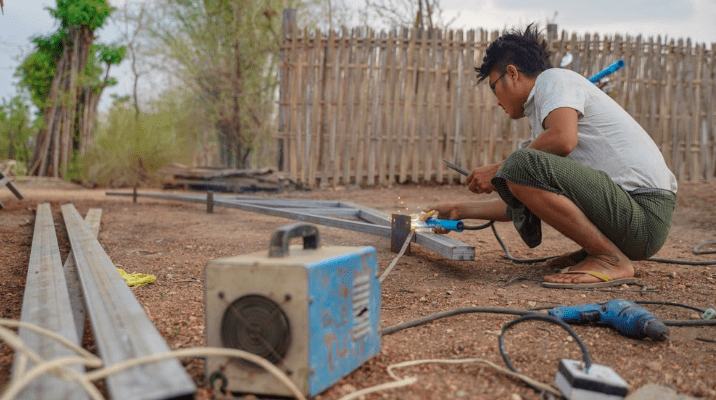Blog
Smart Power Myanmar’s solar energy infrastructure builds resilience against climate risks

The Pact-implemented Smart Power Myanmar project works to accelerate electrification through catalyzing new sources of investment and knowledge to end energy poverty and promote economic opportunity in Myanmar. Smart Power Myanmar has been a leader in wide-scale use of on-grid and off-grid electrification since 2019. Beginning in 2023, the project partnered with The Global Energy Alliance for People and Planet to catalyze solar finance for Myanmar’s commercial and industrial small and medium-sized enterprises.
In this Q&A, Min Chan Win, Managing Director for Smart Power Myanmar, discusses the impact of the project, the value of solar energy in mitigating climate change and the efforts needed to overcome the biggest challenges in mass adoption of clean energy use.
Q: What is the goal of Smart Power Myanmar?
A: SPM’s goal is to improve the adoption of distributed renewable energy to impact jobs, livelihoods and carbon emissions in Myanmar. We help businesses make the switch to reliable and affordable solar energy. We also work with local banks and engineering, procurement and construction companies (EPCs) to ensure businesses have high-quality solar systems. Businesses switching to solar typically reduce their energy costs by more than 50%. Through Smart Power Myanmar, we provide technical planning and support to small-to-medium enterprises seeking solar power and offer financial guarantees to unlock solar loans from Myanmar banks. We also provide design and procurement support to help solar companies deploy reliable systems, and work to unite the country’s renewable energy stakeholders through convenings and networks.
What impact have you seen so far?
We’re only just getting started, but so far, we’ve helped 13 projects receive financing for solar, securing nearly 600 jobs and averting 23,000 tons of emissions. Over the next few years, we plan to support the development of 100 new solar energy projects for commercial and industrial businesses, which would avert 100 million tons of carbon emissions while also catalyzing at least $60 million dollars in local solar investment. By strengthening businesses with cost-effective renewable energy, we expect to create or secure more than 72,000 jobs and improve the livelihoods of 600,000 people.
We have a continuous pipeline of businesses we’re supporting, some of our past successes include Myanmar’s first avocado oil producer and one of the largest rubber factories in the country. While we have a ways to go, our momentum is rapidly increasing, and we are implementing systems to keep up with the demand.
Why is SPM’s work – and solar energy in general – so important when it comes to climate change?
In lower income countries like Myanmar, the impacts of climate change are often felt more strongly due to limited resources, infrastructure vulnerabilities and a higher dependence on climate-sensitive sectors like agriculture and fisheries. Rising temperatures, changing rainfall patterns and extreme weather events threaten food security, water availability and livelihoods, exacerbating poverty and inequality. By investing in solar energy infrastructure, countries like Myanmar can reduce their carbon footprint and build resilience against climate-related risks.
However, catalyzing climate finance is essential to scale up these efforts. Lower income countries often lack the financial resources and technical expertise needed to transition to renewable energy at the necessary pace. This is why SPM is working hard to accelerate the transition to clean energy and promote inclusive growth, energy access and resilience. This not only benefits the people of Myanmar but also contributes to global efforts to address the climate crisis.
What are the biggest challenges for clean energy in Myanmar right now, and how can they be overcome?
There are three main challenges. The first is access to finance. It remains a major barrier to scaling up clean energy projects in Myanmar. Limited access to capital, particularly for small and medium-sized enterprises and rural communities, constrains the deployment of clean energy solutions. Building the financing capacity of local banks is our number one priority.
The second is technical capacity. There is a shortage of skilled professionals and technical experts in Myanmar. We have put considerable time into supporting local engineering procurement and EPCs to ensure that businesses are receiving solar at an international standard. Building local capacity through training programs and knowledge exchange initiatives remains crucial to overcoming this challenge.
The third and final area is confidence in solar. Many businesses in Myanmar distrust or misunderstand solar energy. Much of this comes from the fact that in the past, some businesses took a DIY approach, sourcing low-quality equipment, hiring unqualified EPCs and neglecting maintenance. In turn, the solar installations broke down within a matter of years instead of the estimated 25-30 years for properly built systems. This has resulted in numerous myths about solar in the Myanmar business community. We are working hard to dispel these myths through knowledge-sharing events, testimonials from our successful projects and social media.
Learn more about Smart Power Myanmar and its work at www.smartpowermyanmar.org.